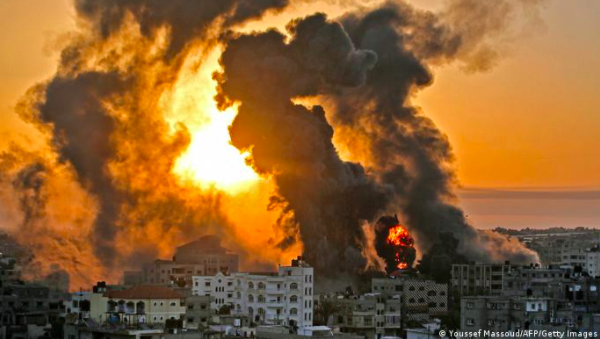On May 6th, 2021, protests started at the old city in East Jerusalem, following an Israeli supreme court to evict six Palestinian families in favour of the Jewish settler organisation, in Sheikh Jarrah district. Following series of civil unrest near the Damascus gate, in the old city, and on the morning of May 10th, the Israeli police stormed the Al-Aqsa compound ahead of the Jerusalem Day Flag March, using rubber bullets, stun grenades and tear gas against Palestinian worshippers who fought back with stones and sharp objects.
Following the escalation of violence, Hamas took advantage of this situation and gave Israel an ultimatum to withdraw from the Temple Mount complex and Sheikh Jarrah by 6:00 pm (local time), before the conflict fully erupted. In response to the Al-Aqsa mosque raid, Hamas launched its “Al-Quds Sword” operation and started the conflict by launching its first batch of rocket volleys towards Israeli settlements. This resulted in a full Israeli military escalation in response to the rocket firing incidents, and the launching of its “Guardians of the Walls” Operation. Thus, sparking a bloody conflict that lasted for 11 continuous days.
The besieged Gaza Strip came under an intensified airstrike and bombing campaign, as sea and naval shelling were also reported against key Hamas, Palestinian Islamic Jihad (PIJ) and Popular Resistance Committees (PRCs) figures, targets, tunnels, MLRSs, storage facilities and safe houses.
Many schools, hospitals and residential areas were either destroyed or targeted following claims and proofs that they were used by Hamas as “human shields” to fire off rockets from within their vicinity.
Despite the adoption of “roof knocking” and “phone calling” techniques to reduce civilian casualties, several tragic incidents were reported such as the Al-Shati refugee camp massacre that took place on May 15th, where 10 Palestinians were killed, mostly children. In the early hours of May 16th, 42 civilians including doctors and children were killed when an hour-long of intense bombing targeted the Al-Wehda district “without any warning”.
Daily violent riots and clashes between Palestinian protesters and Israeli police were reported in East Jerusalem, Sheikh Jarrah District and the West Bank, while international and cross-border pro-Palestinian demonstrations were withheld.
On May 18th, an armed confrontation took place near the West Bank settlement of Beit El checkpoint in al-Bireh, near Ramallah where 3 Palestinians were shot dead and 2 Israeli soldiers were injured. The armed confrontation came in as masked men were seen the night before, fully armed and shooting in the air, urging people to join protests the next day.
On the same day of May 18th, both Erez and Kerem Shalom crossings were temporarily reopened to allow aid trucks and medical supplies to reach Gaza. However, they were closed shortly after being targeted by Hamas’s mortar barrage.
Following a mounting International (Western and Arab) pressure to end this conflict, both Hamas and Israel finally agreed on a ceasefire brokered by Egypt, which took effect on Friday, May 21st, at 2:00 am (local time).
Propaganda and counter-propaganda campaigns on both media and social media platforms were very active during and post-conflict, as each side claims victory.
International and Arab aid and efforts to reconstruct Gaza are ongoing away from any meddling from Hamas, as both Egypt and Qatar offered $500 million each.
Hamas leader Y. Sinwar promised, “not to touch a single cent”. A promise that wasn’t fully fulfilled during the Gaza 2014 war, as many damaged houses remain unrepaired. Thus, questioning the legitimacy of this promise.
Tents have been set on top of the shattered buildings, as Gazans remain displaced. As a result of this conflict, more than 250 Palestinians were killed, which include 66 children, while more than 2000 were injured. Around 20,000 residential areas were either destroyed or partially/fully damaged, while 65,000 remain displaced. The assessed damage is almost similar to the destruction caused by the Gaza war 2014 since the infrastructure was severely targeted. In Israel, 13 people were killed including 2 children and dozens were wounded.
International efforts and negotiations are still ongoing post-conflict to ensure that both sides won’t break the brokered ceasefire, as each side remains “combat ready” for any possible future escalation.
This conflict surely ended Netanyahu’s 12-years rule which caused him a major blow in the recent Israeli elections following the rise of ethnic violence and riots between Arab Israelis and Ultranationalist Jews in mixed cities during the 11-day conflict, causing widespread unrest that resulted in a nightly curfew in Lod. Such a move led the Arab coalition to join Bennett’s ultranationalist party who was approved as a Prime Minister by the Knesset following a narrow win of votes (60-59).
The aim of the newly formed coalition is to:
- Reduce tensions between Palestinians and Israelis which became an ethnic Arab-Jewish confrontation.
- Establish a long-term truce between Hamas and Israel to avoid any future conflict(s) despite both sides’ readiness.
- Maintain current normalisation ties and forge new future ties with other Arab countries to counter the Iranian threat.
- Maintain both US and Western support.
However, it is too early to tell how these aims will be achieved as the main focus remains on the ongoing US-Iran nuclear talks to reach a deal despite the Western sanctions and sabotage acts against Iranian key figures, targets and facilities.

